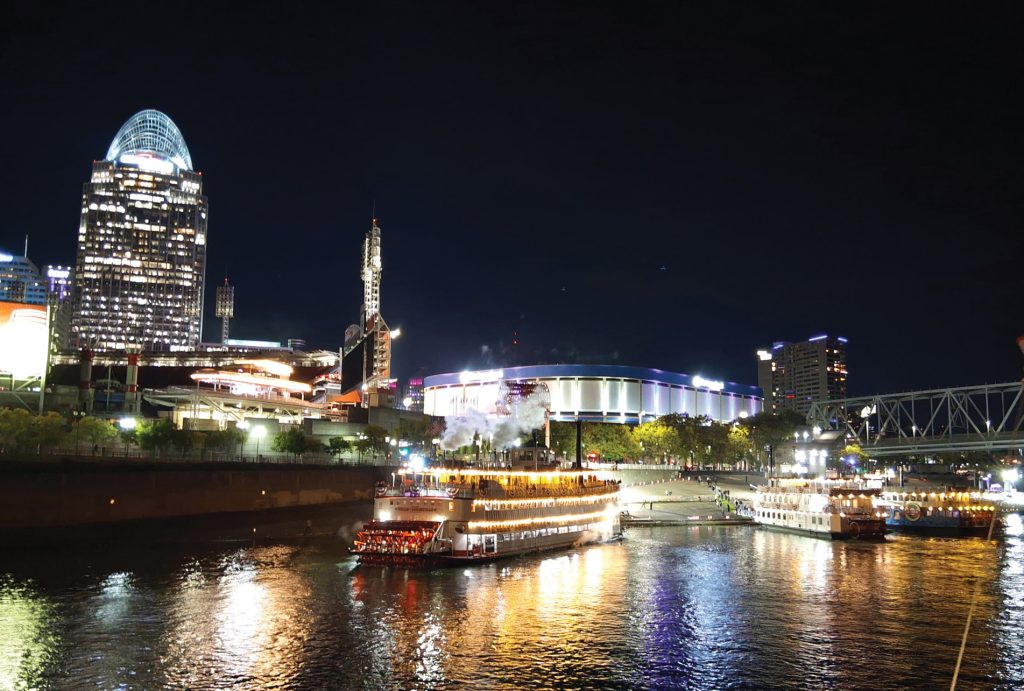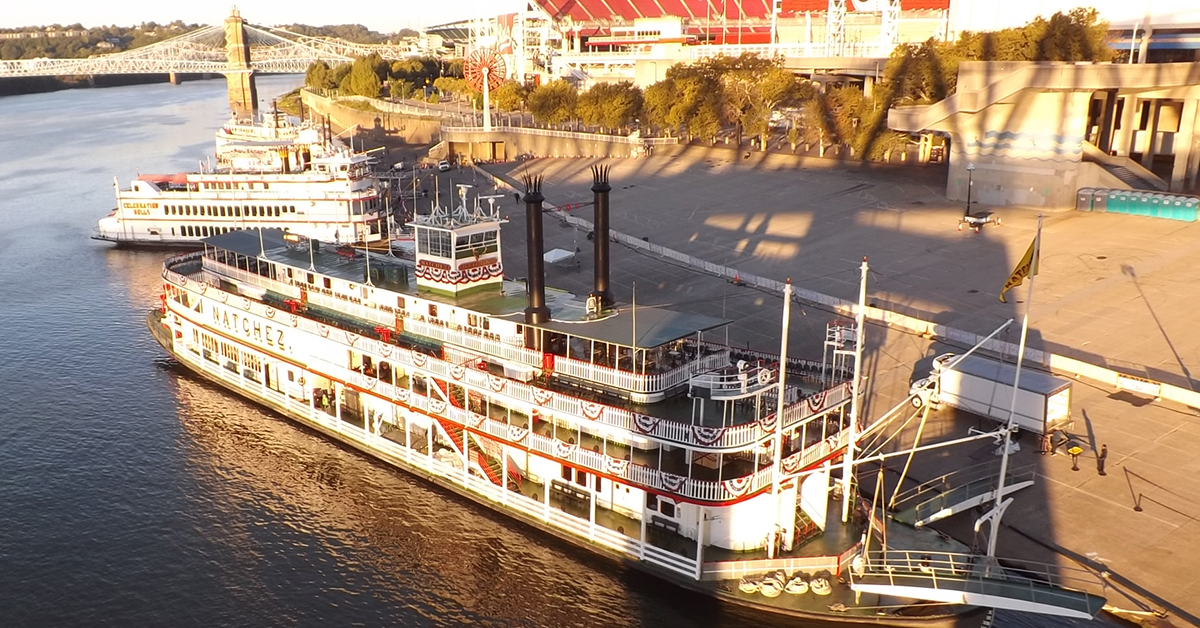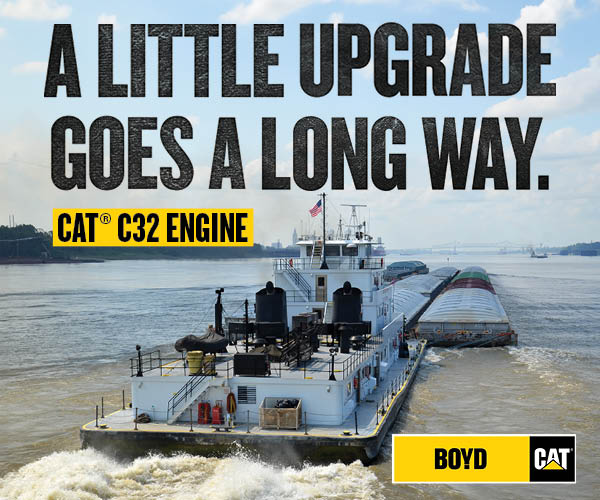The America’s River Roots Festival is over, vanished into the last rollers of wheelwash behind the participating vessels as each departed for their respective home ports. Nine excursion vessels gathered for the event that ran October 8 through 12. Planning for the festival began well over a year ago, with monthly meetings held over the last 12 months.
Thousands of people gathered along the banks of the Ohio River in Cincinnati and Newport, Ky. The five-day festival was the official kickoff to America’s 250th birthday celebration.
Honoring the culture and heritage of America’s river cities, the event included music, regional food, cruises aboard nine riverboats, boat races and boat parades.
Preparation for such a gathering of vessels is a gargantuan task that requires the expertise of many individuals, only looking at the river-related aspects of the festival and not even considering any of the shore-based happenings. Capts. Alan Bernstein and Bill Kinzeler served as co-chairs for river operations. Vessels included the hometown boats from Bernstein’s BB Riverboats, the Belle of Cincinnati and River Queen; the Anson Northrup, pushing the passenger barge Betsy Northrup, both of Padelford Packet Boat Company of St. Paul, Minn.; the Celebration Belle of Celebration River Cruises, Moline, Ill.; the Belle of Memphis of the Memphis Queen Company, Memphis, Tenn.; the Three Rivers Queen of Gateway Clipper Inc., Pittsburgh, and the Mary M. Miller of Louisville, Ky., along with her running mate, the 111-year-old Belle of Louisville; and the New Orleans Steamboat Company’s Natchez from New Orleans. The Belle and Natchez, both true steamboats, were very popular.
In February, a three-day captains meeting was held at Cincinnati, where representatives of each boat met with members of the River Roots organization and the river operations team as well as Coast Guard and emergency management teams and members of both local and federal law enforcement. There was also ample opportunity for local media to interview the representative captains.
As the date of the event grew closer, meetings grew more frequent and plans for vessel services, such as water, sewer and supplies, took shape. Volunteers were recruited to work on the Cincinnati public landing to assist in the cruise queue lines and to direct passengers as they disembarked. By September 28, the boats from the farthest points were underway and headed for Cincinnati. Excitement built as many rivermen and “boat buffs” tracked the progress of the vessels en route.
Also underway to the event and attracting attention was Capt. Bob Harrison, who brought his two historic sternwheel diesel towboats from Bellaire, Ohio. These boats, the Standard, built by Marietta Manufacturing Company in 1923 and the Sewickley, built by Dravo in 1930, formed part of an industry exhibit along the Newport riverfront. Another part of this exhibit was the 3,000 hp. towboat Queen City, owned by C&B Marine LLC, Covington, Ky., and equipment from Living Lands & Waters set up for display and information. The former Corps of Engineers sidewheel steam dredge William S. Mitchell, now used as a haunted boat venue by BB Riverboats, was also open for tours.
Various organizations had information booths set up near the industry exhibit, with one of the most notable being We Work The Waterways, with Executive Director Errin Howard and others promoting careers on the nation’s waterways. Food and beverage vendors and a stage with live music were also located at Newport.
The cruises began October 8 and included sightseeing, brunch, lunch, dinner and specialty trips. The pattern was repeated each day through October 12.
The Sewickley led the opening boat parade on October 9, with boats of the Antique & Classic Boat Society flanking the excursion boats. Three staged races were held throughout the event, and the culmination on Sunday night was another parade, dubbed a “parade of lights,” immediately followed by a fireworks display.
The boats collectively went out on some 160 cruises and carried about 54,000 passengers. A group of river traffic coordinators, made up of experienced rivermen, tracked vessel movements. These included Capts. David Smith, David Reed, Tom Smith, David Dewey and Mike Gore and Coast Guard Cdr. (ret.) Fred Nyhuis. This team also facilitated the passage of 25 commercial tows through the area during festival hours. Gmeni Marine Electronics of Paducah, Ky., and Crounse Corporation of Maysville, Ky., provided electronics for the vessel traffic service. The late Capt. Bill Judd developed a similar coordination system for the early Tall Stacks festivals. The Coast Guard and some law enforcement and emergency groups were located nearby in the same command center area on the BB Riverboats landing at Newport.

Some of the most important vessels at River Roots were the least seen. The Elim Alan towed a small flat that was used to collect the trash from each excursion boat and deliver it to garbage trucks at a landing on the Cincinnati side near the Roebling Suspension Bridge. The C&B Marine’s mv. Bellevue handled the supply barge, servicing several of the participants and delivering food, meals and necessities. There was also a VIP shuttle service via a pontoon boat that delivered staff and employees from one side of the river to the other.
On October 13, the boats began departing for their trips back home. The week of the festival was filled with the sound of air horns, steam whistles and calliope serenades. Of the two steamboats in attendance, the Natchez departed south the morning of October 13 to travel back to New Orleans, and the Belle of Louisville departed north October 14 en route to Kanauga, Ohio, for a scheduled drydock and inspection at Amherst Madison’s facilities.
While there were only two true steamers at Cincinnati, a third was represented, in sound at least. Steam whistles of the size found aboard these boats have distinct characteristics and tone, and it is easy to tell one from another. As the cruises began, a third steam whistle could be heard at times. To those familiar with the deep, mellow tones of this particular whistle, there was no mistaking the voice of the legendary steamer Delta Queen. It had been placed on the roof of the Belle of Louisville, near the calliope. Phillip Johnson, working aboard the Belle of Louisville, arranged for the whistle to be there, even as the Delta Queen itself languishes in Louisiana, awaiting an uncertain fate.
The sound of the Delta Queen’s whistle was an emotional sound to many working on the boats. Capt. Bob Reynolds began his river career aboard the Delta Queen, retired in recent years from Magnolia Marine Transport and served as one of the pilots on the Natchez. He made these comments on social media: “Phillip Johnson brought the whistle from the steamer Delta Queen up from Louisiana to blow on the Steamer Belle of Louisville for the River Roots Celebration. Some might say, ‘Oh, OK,’ but if you know, you know. It always chokes me up, and I don’t apologize.”
————
Featured photo caption: An early morning view of excursion vessels preparing to start morning cruises at the America’s River Roots Festival in Cincinnati. (Photo by Capt. David Smith)



